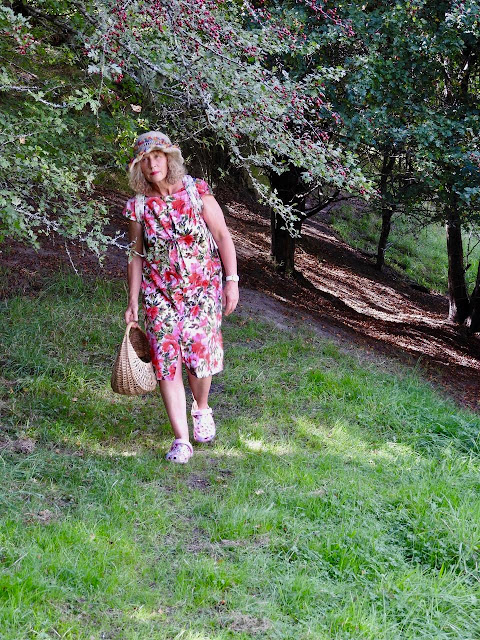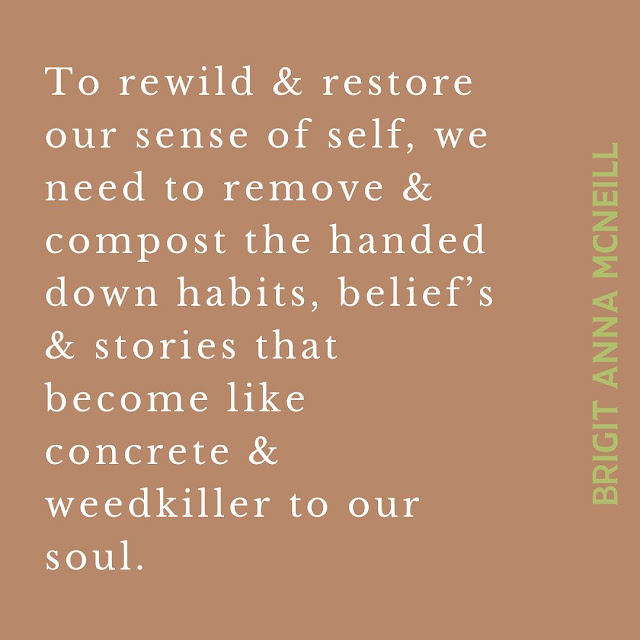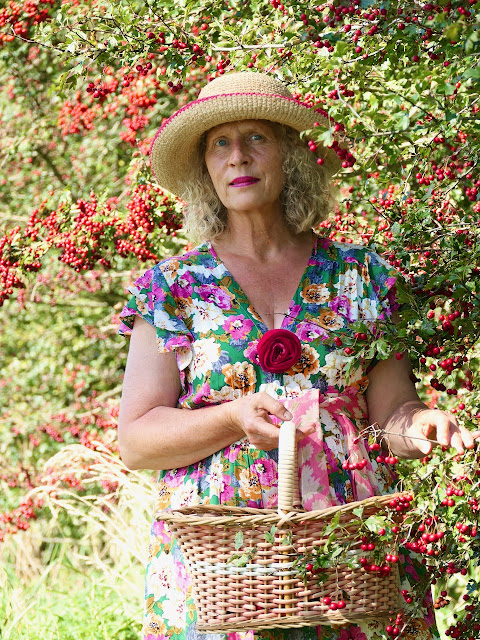When I think of finding Hawthorn I am reminded of Frida Kahlo's words: "Nothing is absolute. Everything changes, everything moves, everything revolves, everything flies and goes away."
And so it is with these trees. When we first discovered Hawthorn fruiting just on the outskirts of Havelock North, we were staying in Porter's Hotel for a few weeks in March 2018. Wattie's had been hideous and we were in negotiation with the company and Zolton (the Australasian manager at that time) booked us in to a hotel. It wasn't actually entirely convenient as Rob was working night shift in Napier, however, it did take us out to Havelock North and we walked in the mornings while we were there. One day we walked up Te Aute road and found a pathway down to the Karamu stream. All along the bank above us we discovered both Black alder and Hawthorn trees. Down by the river we came across swathes of perennial nettles, dandelion and red clover. I went back there so many times after that. I will never forget the experience of meeting Alder and Hawthorn and how they made me feel. They are all gone now- wiped out; ironically erased to make way for the James Wattie Ryman's retirement village.
Later I stumbled upon the most glorious Hawthorns growing along Stock road in Havelock North. I was ecstatic and spent several seasons with these amazing trees.
The next time I went to check on them I was heartbroken to find that they had been removed. All of them! Everything changes... everything flies and goes away. However, as we continued to adventure far and wide, we came across Hawthorn in so many unexpected places. After the violent flooding this year and the destruction the waters wrought on all our beloved places: Rissington, Dartmoor, Puketapu, Eskdale and Ellis Wallace road and more, it was amazing to see when we ventured out to visit Billy and Lanthe in mid March, that there were Hawthorn growing in abundance on the land where they live- the old Wallace property.

The upheaval in this valley was truly breathtaking to witness. You can read about our discovery of Ellis Wallace road and see what the landscape looked like before the floods just
here.The old Wallace land on the hill side is just fine, but out across the valley, over the river the landscape is unrecognisable and inaccessible. For months the locals walked across the broken bridge to get in and out before a new bridge was finally made- only to be flooded again within a week. The old railway bridge- below.
Just over from the railway bridge a new road way has been made and this bridge- photos Hastings District Council 1/4/23
As you turn off the Napier Taupo road and head up Ellis Wallace you'll find a hillside community of Hawthorn trees just on the left.

\
I wondered whether they had prevailed through the cyclone. Billy took this photo in the early weeks afterwards. And here they all are holding the landscape together.

We walked amongst them one autumn
and gathered the most beautiful berries.
I believe these hedgerow trees play an important role in the stabilization of the land in Hawke's Bay
Here they are at the top of the Wallace land.
We had the loveliest wander together.

This Easter (early April this year) I have been struck, once again, by the dissonant focus of the celebration in our neck of the woods. Anyone would think that the southern hemisphere was the poor cousin of the developed world. "Oh it's autumn down there, oh never mind Easter is all spring and bunnies and eggs for us, so you'll just have to tag along". Well, no actually I won't thanks anyway. Neither will I labour the whole deal with the cross, singing hymns and hot cross buns. We are Kiwis, we live in Aotearoa- where is
our authenticity? How can we find our Turangawaewae (
our place to stand) if we're always borrowing someone else's mat, telling someone else's stories and failing to honour the gifts laid on our own doorsteps! If we are not connected to the land, we are not connected to life. If we are not connected to that life, can we honestly say that we have an authentic relationship with the Creator? Our medicine comes from the plants of the land, in the place that we live. The depth of that medicine is based on our relationship with those plants and fungi. Herbalist
Brigit Anna McNeill says
"Paying close attention to the earth, to the heart & body of nature, to witness its beauty & wisdom, is an act of reciprocity not only to the natural world, but also for your life."
Not everyone finds handed down stories weed killer, of course. But those of us who carry trauma, often do. For years I was stuck in a dense, sad misery almost every Christmas, birthday and Easter- cold, helpless and lost. Where was the meaning? Why was there no joy in this choreographed farce? The suffocation of truth- well mine at least. I began to believe that I had no imagination. All the voices condemning my slow living and my yearning for meaning- you're not successful enough, you don't have a real job, you're not good enough, but you're just a "house person". My food was "if you like that sort of thing", my clothes were unsuitable, my weight embarrassing and how ridiculous was I to even contemplate health "care" outside of pharmaceuticals and elective surgery.
The voices wouldn't stop. Their stories were ugly and wrong.
I was awash with shame. My soul shrivelled.
Then one day I met Hawthorn and Wild carrot and Nettles and Linden and a warmth of connection began to nourish my soul for the first time in my life.
And then came Usnea barbata and I started to understand that there was another way of seeing and being in the world. Usnea- slow medicine. It truly is as it grows very. very slowly.
And all I have to do is to show up. Be curious. Be willing to engage, to listen, to learn and to trust.
And then comes: "A will to thrive, to grow well and have a meaningful life."

And from that place comes joy.

And wonder, amazement and simple pleasure in the everyday miracles of life.

Granny McNab Organic Heirloom Nursery!!
After visiting in the Esk Valley we headed out to Otane later in March, as we remembered seeing Hawthorn hedgerows out that way last year.

Sure enough, as we made our way back to White road, we found them again.
Every tree is different, so many variations of berries- some trees have none at all.
Some are just sumptuously plump and crimson.

After all the rain and weather trauma and almost no summer, late March was very warm.
In full blazing sunshine it was a bit of a challenge to pause and be with the trees.
But how beautiful they are!

Such an ancient and much relied on ally from time immemorial.
Herbalist Robin Rose Bennett suggests:
This is as close to a hedgerow as we will ever get.
And so we made our way back to Otane to sit under the shade of grand old Linden trees to have our afternoon tea.

Kawakawa tea, lady finger bananas, homemade cheese biscuits
figs, red and baby kiwiwfruit.
Rumpled "bunnies", but delicious. The secret to red cheese biscuits is to add a little tomato paste to the mix.
Hawthorns and memorials.
And a fabulous local Pataka (store house) for those in need.
All neat and tidy and compassionate.
The following week we headed over to Napier- all the while making new pathways to our days since the old ones have been washed away. Gernot had mentioned Nils and his restored N.O.W Coffee BUS so we made our way to Westshore
and had a fabulous coffee
and a seat on the bus.
We stopped outside the Cathedral in Napier, opened the car door and discovered the most marvellous sight- beds and beds of contemporary echinacea in the most glorious colours.
.jpeg)
And the bees and the butterflies abound!
We eventually got ourselves out to the back of Taradale to Maggie's Way- a hilly walk way through farmland. There is a little bit of wild here and it is so wonderful to roam in the space.
When we first discovered this walkway we came in spring and found ourselves utterly enchanted by the Hawthorn community in blossom.
Who would have thought tucked in beside a posh suburb that anyone would find a grove of Hawthorn trees.
Just like with the berries, the blossoms are all a little different- even occasionally a pretty pink.
What struck us was seeing the Hawthorn family inhabiting the steep hillside that descends into a tiny gentle stream. Once again here they were lining the banks and holding it altogether.
Entirely enchanting.

And so pretty.
.jpeg)
We were so excited to find this space and community of allies and imagined returning here year after year. No wonder they've been called Fairy Trees for all time.
Only some smart arse had other ideas and decided that they should all be removed and banished and natives planted instead. So when the cyclone came in February, the deluge was too much and the hawthorns were gone and the land gave way.
Lots and lots of Kotare (Kingfishers) through this valley.
Looking down through the valley, the trees on the right are still there and this is where we headed to last week (early April),
Down the winding pathway (but this time in autumn)...
and up the steep hillside amidst the Hawthorn trees.
Muted shade, gentle and still
Welcome.
.jpeg)
Peaceful

Magical.
.jpeg)
.
Ah, we found The Mother Tree!
So old, yet look at the her vigour and strength.
The wairua of these trees is all strength, grace, tenacity and wisdom.
Even Stinking iris has beautiful seeds.
The Piwakawakas (fantails) came to us in the trees and then dipped down to play in the water below.
Back down the walk way the offering trees were so very evident. Many had no fruit at all.
Suddenly I saw a young boy glide quietly out the the trees and slip on by. I shot up where he had come from and found myself enveloped by yet another Hawthorn family. Looking through the lense of the Crataegus ssp is a fascinating thing.
The leaves so distinctive.
Like little hands waving.
"Oh there you are!", he said. "Yes, coming- I saw a boy emerge from here and I just had to find out where he'd come from."
I really appreciate the approach to folk herbalism that involves meeting with the medicinal plants that grow around us, season by season, and year by year whether they be herbs, trees, natives, exotics or invasivors. And not just identifying and making botanical observations, but pausing to notice how being with them makes you feel. Sadly many of our own human family members have made us feel stressed, bullied, excluded, stupid, unwanted, aggrieved and frustrated so it was with some amazement that we discovered that when met Hawthorn we were caught up in a radical inclusion and acceptance, enveloped in strong, wise and patient arms. We have never forgotten the feeling of such unfamiliar warmth. In October 2018 we headed out to the Maraetotara stream for a walk by the river and found a beloved grandmotherly Hawthorn tree in a paddock full of thistles. We spent a long time just sitting with this tree and me weeping.
In the autumn as we harvest the berries each year and bring them in to the house to be processed there comes a focus for us- all that Hawthorn has to offer us, and then more as we learn and re-visit the generous nature and gifts of this often maligned tree, well in Hawke's Bay anyway.
It's interesting that no matter which approach you take you simply cannot hurry the harvest of haws. The "song" of the Hawthorn has a steady rhythmic beat, dependable and protective.
Amy from Plant Rhythms suggests that "Hawthorn, without doubt, is one of the best herbs to remind the body what it's like to have normal blood pressure."
The sharp thorns speak of respect and boundaries- practically and relationally.
"Medicinally Hawthorn helps to regulate the vagus nerve and nourishes the heart and opens the blood vessels all the way from the head to the toes, from the center out to the periphery."
Maraetotara Hawthorn in bud.
I make use of the gifts of Hawthorn in every way I possibly can.
Smoky haw sauce is delicious and time consuming to make but a wonderful way to add the goodness of the berries in to our diet.
I also make a decoction of dried haws and rosehips that goes in to one of the kombucha bottles which we drink all year round. Some berries are infused in apple cider vinegar, others in to brandy. In spring I make a separate tincture of the flowers and the leaves and later add all three together.
The double pink Hawthorn flowers have the very best flavour so we visit these trees in late October, early November. Once dried, these blossoms are added in to a tea of rose petals, hibiscus sabdariffa, and sometimes ginger to make a different kombucha again.
The flowers of the double Hawthorn are absolutely exquisite. There are two varieties that we have found around Hawke's Bay: one that is a soft pink called Rosea flore plena and the other a rich deep rose pink called Paul's Scarlet.
There are number of these glorious trees planted along a fence line down Middle road.
They are truly extravagant and an arresting sight in bloom.
In our young nation's history Hawthorn has simply been planted by those who know it as an effective hedgerow plant on rural land, but in European history Hawthorn has a long and magical story to tell. Lots of tales of faery and magic indeed. I wonder how we came to lose our sense of enchantment here? Having spent a good few years with Hawthorn now, through various seasons and times I now know of Hawthorn magic without being told of it.
Luggy knows it too!
"
The magic of Hawthorn is most evident in how he interacts in his environment. Hawthorn is bushy and spreading, and he’s thorny. He provides some food, especially in late winter when his haws are still edible, but more importantly he provides a hedge of protection to a variety of prey animals, most notably small to medium-sized birds. Birds such as the ruffed grouse, robin, cedar waxwing, fox sparrow, and pine grosbeak seek shelter from hawks and other predators in Hawthorn’s thorny space year-round. This tells us Hawthorn is a protector of the small, the vulnerable, and the weak. Hawthorn magic is the magic of shelter and protection, especially in times of stress.Hawthorn’s magic is compassionate. His main pollination source is the fly; his flowers are stinky by most human standards. Yet, from this odorous place is born some of Hawthorn’s most potent and healing medicine. Hawthorn teaches us to recognize the offensive parts of ourselves and our lives, to honor the fruits they bear and to recognize the connection between what is offensive and what is healing. Hawthorn magic is the magic of compassionate perception.
Hawthorn is a steadfast friend. A single Hawthorn can live for 100 years or more, and Hawthorn tends to flourish wherever he’s planted, be it by human hands or otherwise. Whether he’s taken the shape of bush or tree or weed in your life, hawthorn promises to be around a while. Hawthorn endeavors are long-term engagements; they’ll likely have lasting power and significance in your life."
Hawthorn is a steadfast friend and gentle healer that grows well in our province of Hawke's Bay. How glad and grateful we are!
.jpg)







.jpeg)
.jpg)



















.jpeg)



.jpeg)









.jpeg)
.jpeg)
.jpeg)
.jpeg)
.jpeg)
.jpeg)
.jpeg)






.jpeg)

.jpeg)
.jpeg)

.jpeg)
.jpeg)
.jpeg)
.jpeg)

.jpeg)
.jpeg)


.jpeg)
.jpeg)
.jpeg)
.jpeg)
.jpeg)
.jpeg)
.jpeg)












.jpeg)


